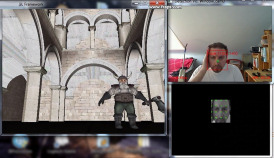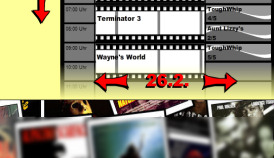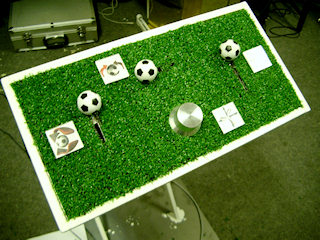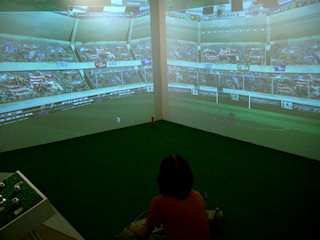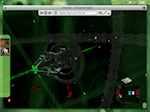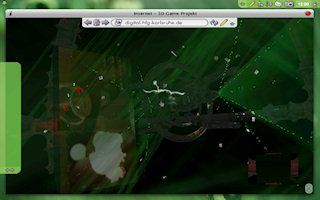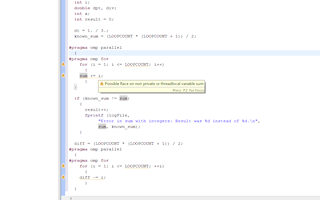

turns coffee into software."
Should the videos on this site be choppy or too demanding for your bandwidth, you may switch to lower quality videos by clicking here:
Switch to low quality videos
Showreel
The showreel on the right demos some scenes from
- LGF Shooter (2004)
- ZKM (2005)
- Goal Machine (2006)
- "Projekt 1834" (2006)
- Aquaricon 2007 (2007)
Projects
Project Description
"Aquaricon2007" simulates a virtual underwater world.
The completely rewritten successor of 2001's "Aquaricon" features
- a rich 3D underwater world
- 10 fully animated fish models
- completely PhysX™-driven fish movement and collision detection
- in-engine webcam support as additional input device and texture source
- influenceable fish-behaviour by interacting with Aquaricon's Touch-Screen or the webcam
- a sophisticated AI to simulate the fishes' behaviour
Middlewares / Engines
Credits
Malte Paetsch (3D Modelling, Texturing)
Dominik Rinnhofer (Project Lead)
Andreas Schuster (additional 3D Modelling, Texturing)
Martin Walser (C++ Programming)
Weblink
Project Description
"Crystal Gate" is an easily integrateable framework for 3D applications, enabling them to use a computer's webcam to track and return the coordinates of the user's face.
Application areas range from adaptive 3D perspectives for museum installations to an intuitive input method for 3D shooter games.
Many gamers - completely lost in the immersion of a game - try to duck obstacles or to peek around corners with their head. But the game won't react and the immersion is lost.
"Crystal Gate" provides a very fast way to add user head movement detection to 3D applications.
Features:
- State of the art face detection
- Multithreading: Cam capturing and face tracking are running in their own thread - as long as there is one free CPU core, the performance drop in the 3D application should be neglectable
- Written in C++
- Support for OpenGL and DirectX
- Very easy API: Basically the integration boils down to two lines of code
Dependencies
Project Description
Goal Machine is an interactive soccer installation which simulates the shot of a banana flank. Sensors installed in a football detect the direction and kick strength. In addition, the goal scorer is able to control strength and direction of wind as well as the spin of the ball at a control desk. In dependence of these parameters the shot at the goal is visualized in real time 3D surroundings and shown as a video projection on two different projection walls. A 4 channel surround sound guarantees a genuine football match atmosphere, where the sporting performance is honored or scorned by the audience.
Features:
- Installation:
- A kickable football containing sensors to measure the force of a kick
- A control console to influence wind and ball spin
- A corner flag rotated by a motor, showing the current wind direction
- Two large screens the virtual stadium is projected on by video projectors
- Software:
- 3D surround sound
- Virtual stadium powered by the OGRE Engine
- Physics simulation with ODE
- Software access to control console, corner flag motor and ball sensors
Libraries / Middlewares
Credits
Malte Paetsch (3D Modelling, Texturing)
Andreas Schuster (Hardware Engineering)
Andreas Siefert (Project Lead)
Per Sterner (C++ Programming)
Martin Walser (C++ Programming, addit. 3D Mod. & Tex.)
Weblink
Project Description
"LGF" deals with the basic idea of information war. It's a multiplayer network game in which you have to collect information and sort them out. That's the only way you can defeat your opponents and escape the might of "The allknowing monolith" which represents the centre of the game universe. This project was a teamwork of students of the HfG Karlsruhe and the TH Karlsruhe (KIT).
Engine
Credits
Arthur Kleer (Programming)
Jan Minar (3D Modelling, 2D)
Malte Paetsch (3D Modelling, Texturing)
Andreas Schuster (3D Modelling, Texturing)
Thomas Pasiek (2D Art)
Shan (Sound)
Per Sterner (Lead Programming, Sound)
David Theis (3D Modelling, 2D, Game Design, Sound)
Martin Walser (Programming, Game Design, Sound, 3D)
Prof. Michael Saup (Mentoring)
Herwig Hoffmann (Mentoring)
Project Description
"MattTV" was a personal project to refresh and train some of my web programming skills.
Following the principles of the 90's classic game "Mad TV", I knocked together a web version of the gameplay combining various web technologies.
To prevent copyright issues the game isn't publicly available.
Web Technologies
- Flash (Actionscript 2)
- HTML
- PHP/MySQL
- Javascript
- Ajax
Project Description
"OpenMPspy" is a convenient and extendable tool working in the background
of the Eclipse IDE, checking for potential or definitive synchronization errors and
providing performance hints while the programmer is still coding.
More than that there's also a command line version allowing users to scan whole projects making "OpenMPspy" a valuable tool even for Non-Eclipse developers.
Credits
Fabian Knittel (Java Programming)
Leonard Masing (Java Programming)
Martin Walser (Java Programming)
Dr. Victor Pankratius (Project Director and Mentor)
Project Description
"Projekt1834" was meant to visualize important local buildings in their look of the year 1834. One highlight of the installation was the "hacking" and utilization of the at that time just released Wii controller ("Wiimote") connected to an ordinary PC as an intuitive control device.
Though the programming was completed, project funding was stopped with the completed prototype,
so the 3D content was never finished.
Engines
Credits
Andreas Schuster (3D Modelling)
Per Sterner (C++ Programming)
Andreas Siefert (Project Lead)
Martin Walser (C++ Programming)
Project Description
The "Wahlkabine" (a polling booth) was an installation for ZKM's "51:49" exhibition. In this fictional ballot, visitors could vote for one of several development plans for Karlsruhe's free-standing "Messplatz" area.
Results from voters at home and voters at the exhibition's booth were stored and added in a MySQL database.
Credits
Dominique Allard (3D)
Yun-Jun Lee (3D)
Jan Minar (PHP/MySQL Programming)
Malte Paetsch (3D)
Thomas Pasiek (PHP/MySQL Programming, Webdesign)
Andreas Schuster (3D)
Per Sterner (PHP/MySQL Programming)
Martin Walser (PHP/MySQL Programming)
Weblink
Project Description
The game "Zentral Kommando Meinungsmassaker" (roughly "Command: Opinion Massacre") was created with Epic's "Unreal Engine 2" (*).
Only at first sight ZKM's aim seems to be survival between media art, other players and monsters.
In fact the game calls for arrangements between the players - Without teamplay "ZKM" can hardly be played for a long time.
At its heart the game represents a three-dimensional questionnaire which's fragments are hidden in the virtual halls
of Karlsruhe's Zentrum für Kunst- und Medientechnologie" (ZKM). Like many questionnaires the answers give feedback
about the player's personal structure. So ZKM is rather a diagnosis instrument than a classic one person shooter game.
By answering the questions the player can slip in the role of one of five different archetypes: the power-oriented
figure of Cleopatra, the glassy average person, the hedonistic fairy, the philanthropic Gandhi or the cunning Loki.
Like in psychological tests each of these archetypes is assigned to a combination of certain answer dimensions.
Teams are built regarding the compatibility of the players' archetypes. So ZKM is a game where it's different opinions
that compete against each other.
(*) Thanks again to Epic Games and Mark Rein for their permission to use their great engine for this game.
Credits
Jan Minar (Programming)
Malte Paetsch (3D Modelling, Texturing)
Thomas Pasiek (Texturing)
Per Sterner (3D Modelling)
David Theis (Level Design)
Martin Walser (3D Modelling, Texturing)
